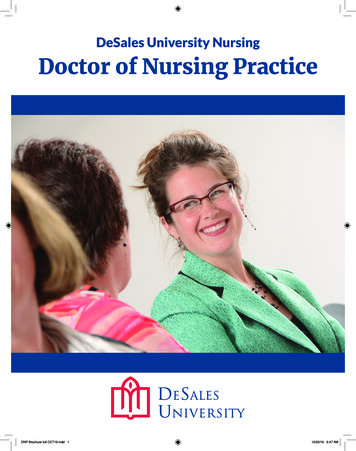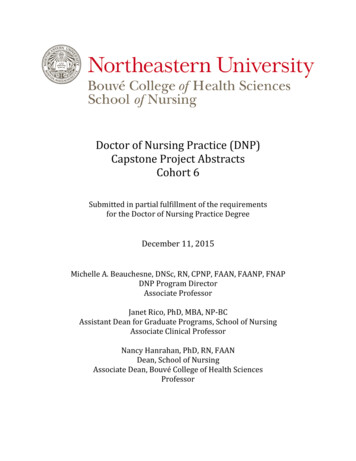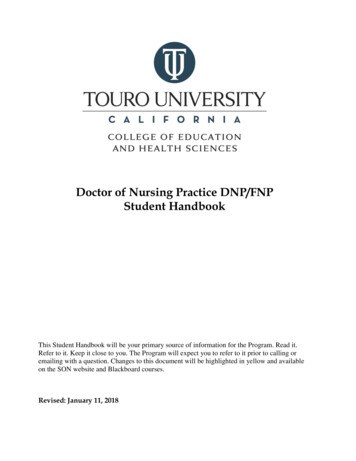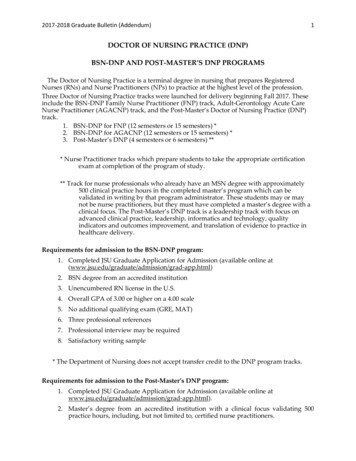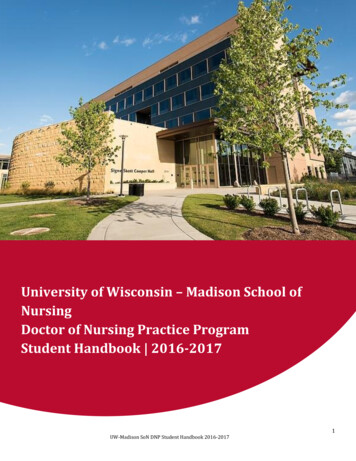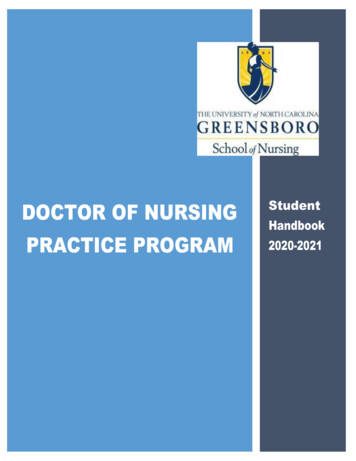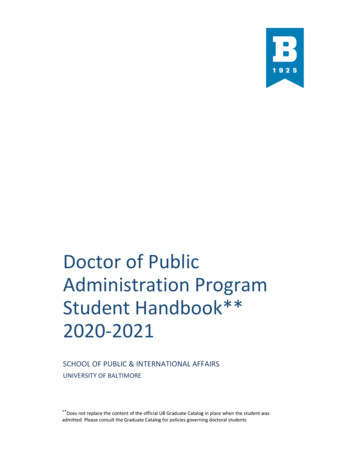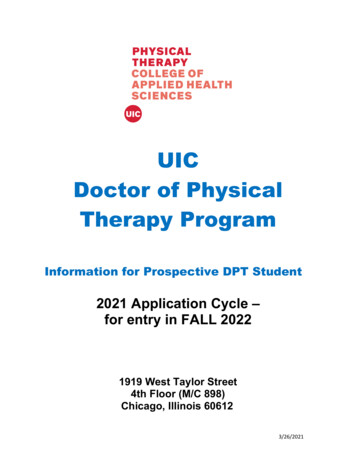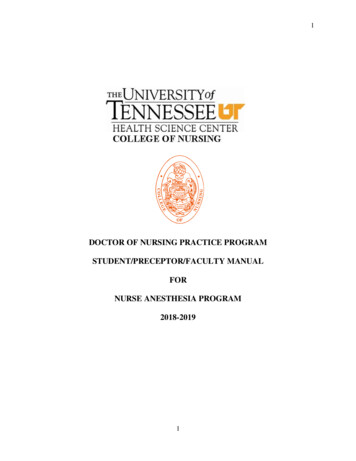
Transcription
1DOCTOR OF NURSING PRACTICE PROGRAMSTUDENT/PRECEPTOR/FACULTY MANUALFORNURSE ANESTHESIA PROGRAM2018-20191
2May 18, 2018Dear Preceptors and Clinical Coordinators,Thank you for the time, effort, expertise and mentorship you provide for our students. Your abilityto mentor our Nurse Anesthesia students is extremely valuable to our students and to the University ofTennessee Health Science Center, College of Nursing, (UTHSC, CON) Nurse Anesthesia Program!The UTHSC CON developed the Nurse Anesthesia Preceptor Guide to provide guidance forstudents, preceptors and faculty from the CON. The preceptor guide contains documents that establishthe Student-Preceptor-College relationship. This relationship provides students with an opportunity topractice their newly acquired skills under the guidance of expert professionals. It is every student’sresponsibility to work with the clinical faculty to create the best clinical experience by negotiating theagreement that matches the course requirements. The Nurse Anesthesia Program assigns students withthe assistance of the designated Clinical Site Coordinator to the clinical site. It is every student’sresponsibility to work with the Preceptor, Clinical Site Coordinator and Anesthesia Faculty to meet allrequirements to enter each institution as a student.The UTHSC CON Preceptor Guide is constantly under review. The content contained in thisversion should be used for students enrolled in any graduate clinical courses. Should you have anysuggestions that will make the clinical experience more valuable, please convey this information with anyUTHSC Nurse Anesthesia Faculty. We appreciate the time and expertise that you share with ourstudents.2
3Student Responsibilities for Clinical ExperiencesNurse Anesthesia courses promote the development of specialized knowledge and skill setbeginning with the application of basic principles and skills transitioning to the application of complexprinciples and skills in the delivery of anesthesia. Preceptors are selected on the basis of theirqualifications to support student achievement of course objectives. Student rights and responsibilities arelisted in the Nurse Anesthesia Handbook.Clinical contracts are obtained between the clinical site and the College of Nursing NurseAnesthesia Concentration. The site designates a clinical coordinator which can be either a CRNA or ananesthesiologist whose letter of agreement and CV is kept on file in the Nurse Anesthesia offices.Preceptor credentialing information is kept at the clinical sites and verification of current credentials isconfirmed by the Clinical Site Coordinator.Clinical hours are scheduled collaboratively by Nurse Anesthesia Faculty and the Clinical SiteCoordinator. Students will work with the preceptor’s schedule and will not ask the preceptor to meet thepersonal needs of the student’s schedule. Any change in the student’s schedule must be agreed upon bythe Clinical Site Coordinator and Nurse Anesthesia Faculty.Appropriate attire for the Nurse Anesthesia Student is covered in the UTHSC CON NurseAnesthesia Dress Code Policy. This policy can be found in the Nurse Anesthesia Handbook. Additionally,guidelines for expectations of the student by the clinical sites are provided in the handbook as well.Student attendance is covered in the UTHSC CON Nurse Anesthesia Attendance Policy,Inclement Weather, and Sick Policy which can be found in the Student Handbook.Dwayne Accardo, DNP, CRNAUTHSC Nurse Anesthesia Concentration Director3
4UNIVERSITY OF TENNESSEE HEALTH SCIENCE CENTERNURSE ANESTHESIA CONCENTRATIONPOSITION DESCRIPTIONCLINICAL COORDINATORDepatment:Nurse Anesthesia ConcentrationPosition Title:Clinical CoordinatorDescription:A Certified Registered Nurse Anesthetist or Anesthesiologist who coordinates the clinicaleducation of students enrolled in the Nurse Anesthesia Concentration.Qualifications:1.2.3.4.5.6.7.8.CRNAs must maintain Registered Nurse Licensure and Authorization as an AdvancedPractice Nurse by the Tennessee Board of Nurse Nursing. Physicians must maintain medicallicensure with the Tennessee Medical Board.CRNAs must be certified by the Council on Certification of Nurse Anesthetists and maintainthat certification as required by the Council on Recertification of Nurse Anesthetists.Minimum of 1 year of experience as a CRNA or Anesthesiologist.Currently active in clinical anesthesia practice.Managerial skills and experience necessary to coordinate student clinical activities.Analytical skills necessary to plan, prioritize, and direct appropriate activities within thedepartment.Effective interpersonal and leadership skills necessary to foster productive workingrelationships.Effective oral and written communication skills.Position Summary:1.2.3.4.5.6.7.Assist the Nurse Anesthesia Faculty in the coordination of clinical education of studentsenrolled in the Nurse Anesthesia Program.Develops and communicates clinical schedules for SRNAs.Directs and participates in the education of SRNAs.Represents program at local, state and national meetings.Continually maintains communication regarding student education issues with NurseAnesthesia Faculty.Oversees the quality of education students are receiving in the clinical area.Responsible for communicating student issues with clinical preceptors at site and with nurseanesthesia faculty.Position Responsibilities:1.Coordination of the anesthesia case assignments of each graduate studentregistered nurse anesthetist in order to:a.Maximize the student’s clinical experience.b.Facilitate the student’s learning in a progressive manner.c.Assist the Nurse Anesthesia Faculty to assure the student obtains the requirednumber of clinical experiences, which will enable them to be eligible to sit for theCertifying Exam.2.Insure that each student has immediate supervision during each of the clinical rotations.Immediate supervision is defined as a CRNA or anesthesiologist with staff privilegeswithin the suite of rooms in which the student is performing an anesthetic who is freeto respond immediately to a summons by the student.4
53.Insure that students are ONLY supervised by a CRNA or Anesthesiologist.4.Define and insure that supervision is exercised during the following Practica:a.DNP Anesthesia Practicum Ab.DNP Anesthesia Practicum Bc.DNP Anesthesia Practicum Cd.DNP Specialty Practicum Ae.DNP Specialty Practicum B.f.Residency PracticumThe preceptor can determine the student is able to function safely within the student’s scopeof practice limitations. Reduction of supervision may occur after discussion of the student’sperformance with preceptor and Nurse Anesthesia Program Faculty occurs. The ClinicalPreceptor RETAINS full responsibility and accountability for the anesthesia care ATALL TIMES.Insures that at no time the ratio of students to Preceptor exceed two (2) students to a facultymember.Maintaining the quality and standard of anesthesia care of students by:a.Discharging the student from the clinical rotation should the student fail todemonstrate patient safety, written care plans, inadequate knowledge, and/orlack of professional demeanor or behavior.b.Evaluating student clinical performance for competency and reporting anypatterns of difficulty in student’s behavioral objectives.c.Notifying Nurse Anesthesia Faculty of discharge or patterns of difficulty withinthree (3) working days of all problems.Maintains case assignment records for the students.Guides and directs the graduate student registered nurse anesthetist and/orPreceptor.Assures that confidentiality is a key issue in the education of any student. Patterns ofdifficulty should be identified to any Preceptor working with a student and/or the NurseAnesthesia Faculty.Recognizes that any other information, gossip, rumors or personal feelings expressedinterfere with a student’s ability to learn in an unbiased setting.Insures that student time commitment consists of a reasonable number of hours and does notexceed 64 hours per week including student study time.Insures that supervision at clinical sites is limited to CRNAs and anesthesiologists who areinstitutionally credentialed to practice and immediately available for consultation.Insures that instruction by graduate registered nurse anesthetists or physician residentsnever occurs if they act as the sole agents responsible for the students.Provide students with orientation to the clinical site either prior to or upon arrival that detailsrole expectations and responsibilities and identifies available learning resources.5.6.7.8.9.10.11.12.13.14.15.5
6UNIVERSITY OF TENNESSEE HEALTH SCIENCE CENTERNURSE ANESTHESIA PROGRAMPOSITION DESCRIPTIONCLINICAL PRECEPTORDepartment:Nurse Anesthesia ConcentrationPosition Title:Clinical PreceptorDescription:A Certified Registered Nurse Anesthetist or Anesthesiologist who supervises the studentnurse anesthetist during the administration of anesthesia.Qualifications:1.2.3.4.Be currently certified or recertified by the Council on Certification of Nurse Anesthetists orlicensed in medicine holding anesthesia specialty training.Maintain a current, valid, professional / registered Tennessee nursing/physician license inone jurisdiction of the United States, which satisfies the requirements of the applicable stateboard of nursing or medicine.Participate in continuing education / faculty development activities, which enhance their roleas CRNA or MD educators.Demonstrate competency in their area of responsibility and be knowledgeable in the teaching/ learning process.Position summary and responsibilities:1.2.3.4.5.6.7.8.9.Supervises the student nurse anesthetist during the administration of anesthesia.Recognizes pathophysiology states of the patient that are pertinent to the anesthetic.Discusses the patient’s status and rationale for the anesthetic management with the studentand the anesthesiologist.Evaluates the student’s clinical performance and constructively discusses this performancewith the student and faculty of the Nurse Anesthesia Program.Teaches by discussion and by demonstration.Informs the Clinical Coordinator, Program Director and/or Associate Program Director ofpertinent student performances.Supervises the student anesthetist in the immediate post-operative care and evaluation of thepatient.Encourages the student to ask questions and think critically.Discharging the student from the clinical area should the student fail to demonstrate patientsafety, written care plans, inadequate knowledge, and/or lack of professional demeanor orbehavior.Legal Liability while Precepting StudentsPreceptors are liable for the care provided to their patients during a preceptorship arrangement.Patients should be informed that the preceptor remains the primary anesthesia provider and isresponsible for decisions related to patient care during the perioperative experience.Legal and reimbursement guidelines require that preceptors validate findings on physicalexamination, review laboratory tests, and confirm differential diagnosis (es) and management plans withstudents prior to the perioperative management of the patient. Review by the preceptor must be6
7documented in the record indicating that the preceptor has examined the patient, is in agreement with thefindings and plan as written by the student and is responsible for care. It is customary that the preceptorco-signs all records in which the student has provided documentation. Third party payers, government,and insurance companies cannot reimburse for care provided by the student.Liability InsurancePreceptors assume the same liability for their patients as other practitioners in clinical practiceand have the added liability of closely supervising the student.Registered VolunteersThe University of Tennessee recognizes the valuable contributions of those persons giving freelyof their time and talents for the benefit of the University without compensation. These persons are"VOLUNTEERS" in every sense of the word. The State legislature in the enactment of the TennesseeClaims Commission Act of 1984 recognized the need the protection of volunteers from legal actions whileperforming their service on behalf of the University. As such, the volunteers who are registered with theUniversity receive the same civil immunity from liability, as does an employee of the University under theAct. Volunteers under the Claims Commission Act are not covered for Worker's Compensation.The term "Registered Volunteer" means those persons who are not employees of the University whoprovide service to the University in an approved program that are listed and reported to the Division ofClaims Administration, State of Tennessee.To become a "Registered Volunteer", the individual must be designated as a clinical sitecoordinator for the Nurse Anesthesia Program.Evaluation of StudentsPreceptors meet with the student formally at the beginning of the day to review the student’s planof care. The preceptor will provide both formative and summative evaluation. The summative studentclinical evaluation form provided by the UTHSC CON Nurse Anesthesia Program should also be reviewedwith the student at this time.7
8Two types of evaluation are important in the Nurse Anesthesia program, formative and summativeevaluations:Formative evaluation is an assessment by the preceptor in the form of feedback to the studentregarding their performance during the clinical experience. Ongoing feedback provides the student withthe opportunity to enhance their performance during the day and the course of the clinical practicum. Roleperformance areas in which the student has achieved competence should be discussed with the student,as well as those areas that have been identified as weak, and needing improvement. Specificrecommendations from the preceptor on strategies for improving clinical performance will be helpful to thestudent and can be documented in anecdotal notes and midterm evaluation.Summative evaluation is the assessment of the student’s performance at the end of the clinical day.The summative evaluation describes the student’s performance, development, and improvement. Thesummative evaluation of performance is based on the criteria indicated on the clinical evaluation toolprovided by the Nurse Anesthesia program faculty. Although students are often not able to meet theperformance competencies immediately, they should be able to demonstrate progression of skills andcompetencies. The written narrative is an extremely important part of the evaluation. Comments arevaluable in assessing the student’s knowledge, skill level, and immersion in the course. Clarity ofcomments and specific examples of situations that illustrate the comments written on the evaluation formare important to learning. Written comments are particularly valuable if the student needs remediation in aspecific competency area, if the student is for any reason reviewed by the Progressions Committee, or iffaculty are asked for a recommendation of the student’s clinical ability. The evaluation should be reviewedwith and returned to the student at the end of the day. The student’s self-evaluation is also important toincorporate during the preceptor/student evaluation discussions.Summative and formative evaluations provide the preceptor with the tools to identify and discussdeficiencies that may indicate patterns of difficulty in clinical performance. It is strongly recommended thatpreceptors inform faculty of clinical performance deficiencies and/or problems at the time they occur. Inthis way, faculty can assist both preceptor and student in optimizing the educational process.8
9Preceptors should document anecdotal notes that can be used to develop the mid-semester and endof semester evaluation. Student strengths, as well as challenges, should be documented. In the eventthat a student's behavior is unprofessional, or the student places the patient in danger (e.g. patient safetyconcerns) , an anecdotal note should document the event and the course faculty must be contacted. Thecourse faculty will meet with the clinical preceptor and student. The Faculty will decide if take furtheraction is appropriate.Faculty will provide preceptors with the appropriate evaluation tools before the start of the semester.The evaluation tools should be reviewed and clarified; examples should be used to demonstrate differentlevels of student’s abilities as reflected in the written evaluation. The preceptor may seek clarificationabout the evaluation process with faculty members. Please contact Faculty with any questions, concerns,suggestions or comments9
10Preceptor BenefitsOutstanding Undergraduate and Graduate Preceptor AwardsEach year, the College of Nursing acknowledges preceptors who make outstanding contributionsto the clinical education of students. Preceptors are nominated by faculty and supported by individualstudents who have been taught by the outstanding clinical preceptor.Graduating nurse anesthesia students select an outstanding preceptor. This individual is invited to theNurse Anesthesia Student’s Ether Ball and presented a plaque recognizing the preceptor’s significantcontribution to nurse anesthesia education.Under the new NBCRNA recertification rules, precepting Nurse Anesthesia students providescontinuing education credits that can be used in partial fulfillment of reaccreditation.Nurse Anesthesia Evaluation ToolsEvaluation is an essential component of the educational and accreditation process. The UTHSCCON Nurse Anesthesia Concentration General Policy on Self-Assessment in the Nurse AnesthesiaStudent Handbook covers this. Students are required to complete their portion of the daily evaluation toolprior to giving it to their preceptor. Completion of the student’s daily evaluation is critical.10
11Preceptor-related Web-based Resource Resources and Links for preceptors can be found on the home page of the PreceptorDevelopment Program from the Southern New Hampshire Area Health Education Center,http://www.snhahec.org/preceptor development.cfm (website supported by HRSA FamilyMedicine Training Grant) Link was checked for function on May 31, 2018.Useful WebsitesOrganizationWebsiteAmerican Academy of Nurse Practitionershttp://www.aanp.orgAmerican Association of Nurse Anesthetistshttp://www.aana.comAmerican College of Cardiologyhttp://www.acc.orgAmerican Diabetes n Heart Associationhttp://www.americanheart.orgAnesthesia Patient Safety Foundationhttp://www.apsf.org/Center for Disease Controlhttp://www.cdc.govIndex of clinical trials: The Cochrane Libraryhttp://www.cochrane.co.ukNational Library of Medicine Medline searcheshttp://www.ncbi.nlm.nih.gov/PubMedNational Guideline Clearinghousehttps://www.ahrq.gov/Pulmonary assessment:1) Chest pulmonar/pulmonar.htmPreventive Medicine: Report of the U.S.Preventive Serves Task -chroniccare/decision/uspstf/index.html11
12Virtual Anesthesia /index.shtmlInternet addresses are case-sensitive. Web addresses may change; links checked for functionality May 31,201812
13University of Tennessee Health Science CenterNurse Anesthesia ConcentrationAlumni Evaluation FormDate: July 2, 2018Name:Work Model (Please circle one):Type of Facility:CRNA-onlyMD SupervisionMD Medical DirectionPlease respond to each statement in a manner which best reflects your thoughts and feelings:1 Strongly Disagree2 Disagree3 Unsure4 Agree5 Strongly AgreeOverall, my didactic instruction prepared me to function as a CRNA.1 2 3 4 5Overall, my clinical practicum experiences prepared me to function as a CRNA.1 2 3 4 5I understand and fulfill the practice standards of the profession.1 2 3 4 5I take responsibility for and I am accountable for the care I provide.1 2 3 4 5I demonstrate sound professional and ethical standards of practice.1 2 3 4 5After gradua
with the student and faculty of the Nurse Anesthesia Program. 5. Teaches by discussion and by demonstration. 6. Informs the Clinical Coordinator, Program Director and/or Associate Program Director of pertinent student performances. 7. Supervises the student anesthetist in the immedi
